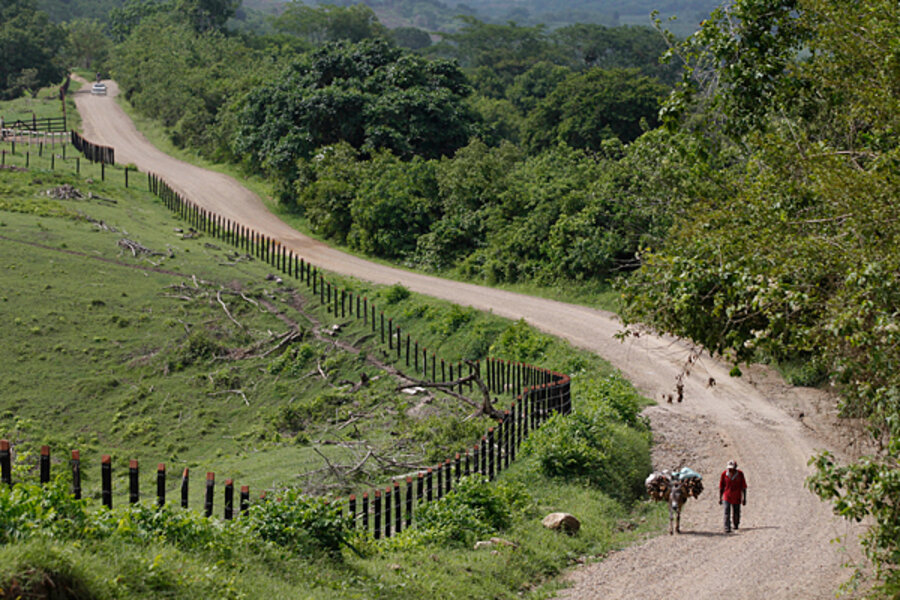Can Colombia really return lost land to owners displaced by conflict?
Loading...
| CODAZZI, Colombia
Juan Manuel Rodríguez was in high spirits when he received notice last month that 16 years after being driven from his farm near this town in southern Cesar Province, his right to the land was restored, and he could go back to a life that was interrupted by violence.
Mr. Rodríguez bought food for a month, hired a team of workers, and set out to clear the land he deserted in 1997 after paramilitaries killed 10 neighbors and torched dozens of homes.
But just 11 days after reclaiming his land, Rodríguez was forced to abandon it again. In late August, an armed man came onto his property and ordered Rodríguez’s workers to leave, claiming he was the true owner. The workers fled and Rodíguez hasn’t returned since.
"I've been displaced again," he says. "I have the papers that say the land is mine but I won't go back there until I'm sure it's safe. I've seen enough violence for a lifetime."
Rodríguez is among the first in the province to benefit from the Colombian government's banner land restitution program, which aims to return millions of victims of the country’s half-century-old conflict to the estimated 6 million hectares of abandoned land. Much of the land left behind spuriously ended up in the hands of third parties over the course of the conflict between rebel groups, paramilitaries, and the government.
But the intimidation and threats that Rodríguez has suffered for reclaiming his land are part of a pattern of widespread abuses that threatens to thwart land restitution efforts, according to a new report by Human Rights Watch launched today in Bogota. This could have widespread implications for Colombia as it struggles to establish a peace accord with rebel groups to end the conflict, and work toward reparations and a sustainable peace.
“In Colombia, trying to get your land back often means assuming risk and living in fear," says José Miguel Vivanco, Human Rights Watch director for the Americas.
'Sabatoge?'
The struggle for land is often cited as a core cause as well as a consequence of the conflict in Colombia, where landownership is still a source of political, social, and economic power.
The report documents the murder of 21 people since 2008 where researchers found "compelling evidence" that the attacks were motivated by the victims’ land claims. Dozens of other deaths believed to be related to the reclamation of land are under investigation by prosecutors. Hundreds of others reclaiming their land across Colombia have received credible death threats in the form of leaflets, menacing phone calls, and invitations to their own funerals.
“President [Juan Manuel] Santos is making a serious and unprecedented effort to return land, but violence and intimidation against displaced families attempting to return home threaten to sabotage his banner human rights initiative,” Mr. Vivanco says.
Officials knew it was never going to be easy, says Ricardo Sabogal, national director of the government's land restitution office. "Obviously we knew that a policy such as this was going to step on some very powerful toes and affect dark interests," Mr. Sabogal says.
Whenever a land claimant is threatened the case is taken to the National Protection Unit, which conducts a risk study and can offer protective measures, he says. The relatively low number of murders compared with threats reported speaks to the effectiveness of the protective measures, according to today’s report.
However, Human Rights Watch says there is a need for more than bulletproof vests and bodyguards to keep claimants safe and move Colombia forward. "Meaningful protection will require holding the attackers accountable, and breaking the grip paramilitary mafias still have in areas where displaced families are trying to return,” said Vivanco.
Moving in
After Rodríguez and other farmers from the property, known as El Toco, fled their farms in the late 1990s, the land was taken over by Hugues Manuel Rodríguez a well-known cattle rancher and paramilitary warlord who went by the name "Commander Barbie." Locals say Barbie installed a paramilitary base on El Toco and filled it with his cattle.
In 2006, as paramilitaries in the region were demobilizing, Barbie’s lawyer handed the property over to the government’s land reform program. The plots were then distributed to a group of farmers, some of whom were allegedly tied to the paramilitaries, including Barbie’s former driver, reports Human Rights Watch. Only a handful of the original farmers recovered their plots at that time. Barbie, who is reportedly living in Maryland, was convicted in absentia in Colombia for criminal conspiracy in 2007.
The group of original farmers at El Toco call those who are on their land today "the opposition," and blames them for the threats against Rodríguez and others. Miguel Serna, the leader of land claimants in El Toco, has survived two murder attempts and dozens of threats. Leaflets come adorned with images skulls and crossbones, Uzis, AK-47s, and pistols, and are signed by neoparamilitary groups known as Rastrojos and Urabeños or leftist rebel groups such as the FARC, which is currently engaged in peace talks with the government.
Some threats come in the name of the so-called Anti-Restitution Army, though local and national officials say it is not likely a structured armed group, rather a name used by those who want to intimidate claimants.
No land claimants in Cesar Province have been killed, but an official with the governor's office who spoke on condition of anonymity echoed Human Rights Watch in warning that as the restitution process advances, the problem could become more serious.
"There have only been 10 sentences so far, out of more than 1,200 claims here. We'll have to wait and see what happens when more land starts being returned," he says.





